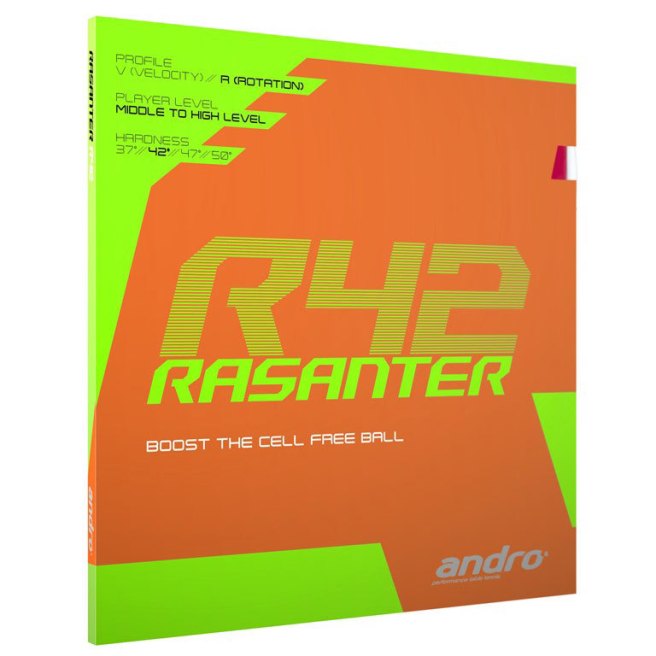I am an all-round style player who uses an attacking blade, Victas Koji Matsushita Offensive This blade allows me to attack at the table or defend from afar and play anywhere in between. This is one of my favorite blades.
I regularly flip my racket. I use 2 types of long pips: andro Rasant Chaos and TPS Curl P1R. Each has its advantages and disadvantages.
But it’s mostly my forehand that I would like to address today. At the beginning of the season, I decided to test andro Rasanter R42 and Donic Bluestorm Z3.
Now, after almost 6 months, I still have not decided which one I prefer. In fact, it depends on the situation: whether I am in better shape to counter-attack or not, and who my opponent is.
It is very interesting to compare these two rubbers.
Features Of andro Rasanter R42
Your profile is spin driven. You are looking for maximum grip with your rubber. As an advanced to a high level player, you will benefit from a medium 42° sponge hardness taking full control of your spins. Your style is versatile and you’re smart enough to achieve the fullest topspin potential of the rubber. Its medium soft sponge guarantees superior feedback and control, while at the same time adding extra speed.
My Experience With Rasanter R42
Speed: 8.5/10
Spin: 9/10
Control 9/10
Throw Angle: Medium (easy to predict)
Dwell Time: Sufficient
Hardness: average (42°)
Weight: Light for max thickness
Range of Shots: All shots work well with this rubber
Shot Control: Very good, easy to discern where shot is going
Durability: It would be time to change after 6 months of intensive play.
At The Table
The spin is maximized, even with the plastic ball. Finally a rubber that allows me to vary trajectories and amount of spin, and also allows me to put a lot of spin if I desire. And control is very good, which is extremely important for a defensive player who precisely places his shots.
In A Match
My serves have a lot of spin and it’s easier for me to control the speed of my fast services because of the extra spin I can put on the ball. For serve return, the short game is easy to control. Short pushes are effective. Long pushes are spinny and biting. Flips are easy to execute on both forehand and backhand. The banana flip is effortless.
R42 is as effective at the table as it is at mid-distance when I counterattack or initiate attack from a distance. Sidespin is particularly effective given the amount of spin that I can put on the ball. On the other hand it is difficult for me to take the advantage in loop to loop rallies.
Defensive chopping from the forehand is also easier because the trajectory of the ball is easy to predict and control. My chops can carry lots of spin.
Features Of Donic Bluestorm Z3
Z3 with its large pored 42.5° sponge is considerably softer. This makes a big difference. One not only feels it but also hears it. Lovers of freshly glued rubbers will delight in the sound. An attacking stroke with Bluestorm Z3 sounds like the crash of thunder, yet the topspin player remains in full control. Most suitable for All-round+ to Offensive players.
Control: 8
Speed: 9+
Spin 10+++
Hardness: Soft+
Topsheet: Elastic and spinny
My Experience With Donic Bluestorm Z3
Speed: 9.5/10
Spin: 9.5/10
Control 8/10
Throw Angle: Medium (more difficult to predict than R42)
Dwell Time: Sufficient
Hardness: 42.5°
Weight: Heavy (noticeably heavier than R42)
Range of Shots: All shots work well with this rubber, especially attack shots.
Shot Control: Good, a bit harder to discern where shots will land than R42
Durability: It would be time to change after 4 months oaf intensive play.
At The Table
Speed and power are main advantages of this rubber. Spin too, but after 3 months of play, I felt that my Z3 generated less spin than my R42. Speed of the loops and smashes, especially against topspin, is more than enough to win points. On the other hand, it is more difficult to control when chopping defensively against the smash.
In A Match
My serves are less effective in general than with R42. However, my fast serves are more devastating.
During serve return, short pushes are efficient. Fast pushes are very fast, but have less spin than with R42. Fast flips are easier to execute than the backhand. The banner flip is easy to perform. But it’s harder to make effective flips.
Z3 is effective mid-distance in terms of speed and power. Easy to make powerful topspins. More difficult to vary spins and trajectories.
Defensive chops on the forehand against topspin is harder to control, but the fastest smashes are easy to return.
Conclusion
When I decided to try these two rubbers, I expected them to be quite similar considering the hardness of the sponge is about 42° for both. I thought I could choose the one that best suited my game after a few weeks. But that was not the case.
Z3 is definitely heavier and denser than R42, making it harder to use. Z3 promotes power and speed and therefore, counterattacks. The lighter R42 allows me to put more spin on the ball and offers better control of my trajectories in both defensive chopping and offensive topspins.
So if I play an opponent who plays with power and smash, where I need more power to counterattack, I use Z3 on my forehand. And when I play an opponent who has difficulty with variations in spins and trajectories, and I need more control in service, delivery, and for flipping, I use R42.
In short, it’d be great to have a 3-sided racket!



